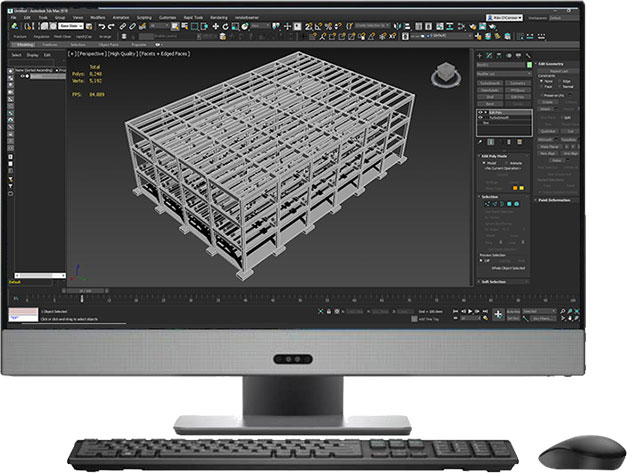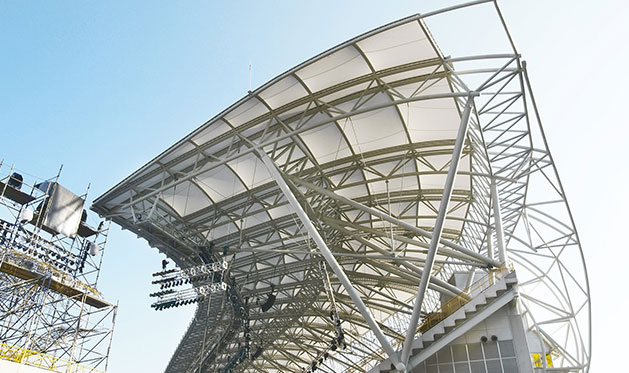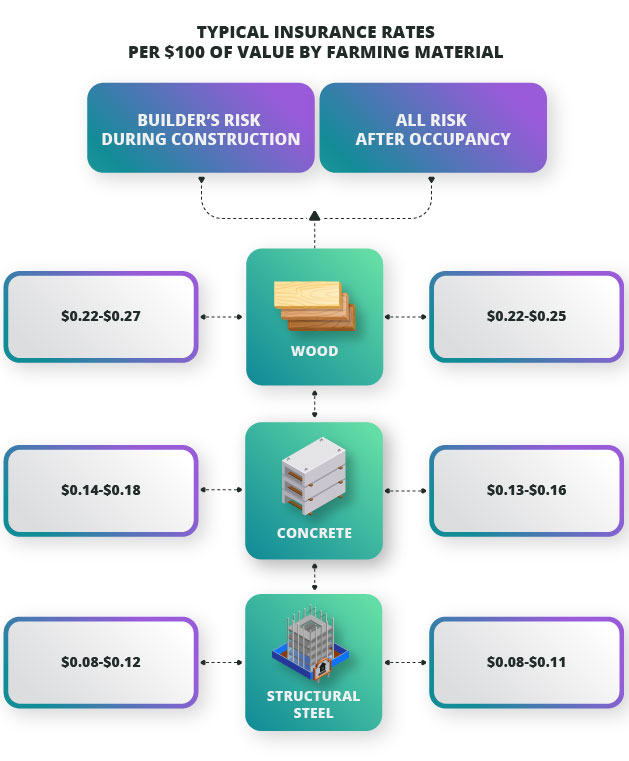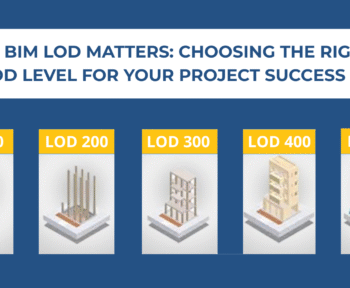The demand for sustainability has led to an increase in the construction of steel concrete structures. The reason is uncountable advantages – high strength, elasticity, toughness, lightweight, and ease of fabrication. Application of steel has leaped up the value of global construction to $11 trillion and is estimated to reach $14 trillion by 2025.
Steel structures require precise and accurate steel detailing to withstand hazardous or natural calamities. Supporting in error-free installation and fabrication of steel components, steel detailing helps in creating detailed erection drawings and shop drawings.
Steel detailers follow specific detailing standards set by different international institutions, such as the American Welding Society, BCSA, Iron & Steel of Japan. These detailing standards vary with geography. Countries follow a specific set of detailing standards developed by these institutions.
eLogicTech Solutions has expertise in steel detailing and an in-depth understanding of international standards. As part of our steel detailing service, we follow the standards specified by the client to meet the regulatory requirements of the target geography.
Steel detailing standards mandated by different regions

Steel detailing standards varies across the region. The project structure and sustainability depend on the land and its climatic conditions. Therefore, the detailing standards should meet the terrain type, climatic and geographical conditions of a region.
The drawings should comprise all the essential information, ensuring each piece of information mentioned in the detailing is correct. Building product manufacturing companies use these shop drawings and erection drawings for the fabrication and installation of the steel components. Detailing errors such as dimensional mistakes, bills of materials miscalculations, missing pieces, clearance of welding, etc., can result in wastage of resources and time.
Different institutes and confederations in several parts of the world have developed many steel detailing standards appropriate for the specific regions through research and analysis.
Design standards used by the American continent
American Institute of Steel Construction (AISC) – AISC’s authoritative volume on the steel building structure, AISC 360 Specification for Structural Steel Buildings, is referred in all U.S building codes. AISC has also published seismic provisions for structural steel buildings. Industry guidelines in the context of safety of steel structures for nuclear facilities, RCSC specifications for structural joints using high-strength bolts, etc.

American Welding Society – The American welding society has published ‘Welding Journal’ to spread awareness of welding importance and new fields for its use. It also offers several certification programs for welding-related disciplines.
Canadian Institute of Steel Construction (CISC) – The CISC Code of Standard Practice for structural steel guides current practices in the Canadian structural steel fabrication and erection industry.
Brazilian Steel Institute (IBS) – IBS conducts study and research related to steel production, equipment and technology, raw materials and energy, market trends, new steel applications, and industrial relations. It also forms programs and policies and aims to protect the Brazilian steel-producing industry, acting towards sustainability.
Europe’s detailing standard companies
British Constructional Steelwork Association (BCSA) – BCSA represents the British steel fabrication industry, the wholly-owned subsidiary of BCSA, Steel Construction Certificate Scheme provides certification services to steel contractors and steel supply chain.
Norwegian Steel Association – Norwegian steel association mainly concerns the construction products regulation. And standards for steel design and execution, including CE-marking.

The European Confederation of Iron and Steel Industries – European Confederation of Iron & Steel Industries comprises steel companies and national associations in Europe. It promotes cooperation among its members on all issues related to the steel industry and its development.
Asian detailing standard companies
China Steel Construction Society – China steel construction society is a national professional organization of economy and technology and includes enterprises and undertakings from the Chinese construction field. It has a directed journal named ‘Steel Construction’ columns on tall steel structures, steel housing buildings, steel structures for bridges, standards & codes, etc., are listed in it.
Japanese Society of Steel Construction (JSSC) – JSSC is the quality control body of constructional steel structures in Japan. It is also the deliberative body of ISO/TC167, which participates in TC and Steel material, design, fabrication, and erection.
Few other Steel detailing standards associations in the Asian sub-continent are Taiwan Steel and Iron Industry Association (TSIIA), Malaysian Structural Steel Association (MSSA), and Korean Iron & Steel Association.
Design standards associations in African countries
The Southern African Institute of Steel Construction (SAISC) – SAISC is the leading facilitator in the development of steel construction and related manufacturing sectors in South Africa. Its subsidiary associations are South African light steel frame building structure, International Steel fabricators, Power line association of South Africa, etc.
African Iron & Steel Association – African Iron and Steel Association promotes in development of iron ore mining, iron and steel industries, and processing, distribution, and consumption of iron and steel products and sub-products.
Steel detailing practices followed to meet the standards
Steel detailing practices need to be aligned to the regional standards to meet its objective. Some of the detailing practices listed in the AISC manual are as follows.

Basic detailing conventions
The standard detailing (shop and erection drawing) conventions used today are –
- Clarified details in shop and erection drawings make a better presentation. Also, standard text, good line contrast, well-presented sections, etc., be used.
- Appropriate ANSI/AWS symbol to be used for welded joint and avoid the use of more welding.
- Shop and field considerations should be ensured to cover variations while cutting, shearing, and coping.
- The detailers should be aware of the current document, such as Research Council on Structural Connections, for getting all information on a bolt.
- The detailer should mention in each shop drawing if the painting of pieces on the sheet is required or not.
Project set-up and control
When a project commences, the project team must hold a meeting with all the members of the construction team. Based on the requirement and operational consensus, a guideline is developed for detailing, fabrication, and erection all through the project.
The project guideline must cover the following –
- Review the contract document and general contract, applicable codes, OSHA requirements. And also, areas of the structure to be re-designed.
- Review the detailing methodology that has to get used, fabricators, and erector’s standard details.
- Propose alternate details and discuss the missing or ambiguous information
- Discuss advance bill of materials (BOM).
Shop drawings and BOM

It is detailing for steel construction, manual lists down techniques used by detailers to present information clearly and concisely to the fabricator.
Some common errors that should get avoided while creating shop drawings are detailing mistakes, missing the pieces, clearance for welding & bolting, bolt holes representing the wrong diameter, omitted connections, use of incorrect steel, etc. In BOM, avoid errors such as billed weight or the size of a rolled shape mismatching the drawing description.
Detailing Quality Control
The independent, Steel detailing firms may volunteer quality certification programs such as the AISC Quality Certification program, Quality procedures program by the National Institute of Steel detailing to get the certified top-quality practices.

Other functions required for QC are checking all documents of the detailing process, backchecking by the detailer, approval of drawing by SER (Structural engineer of record), and record maintenance.
Benefits of steel detailing best practices
Adhering to the best practices of Steel detailing and Standard codes brings numerous benefits to the detailers, fabricators, erectors, and the whole project. Some of the benefits are listed below.
A clear perception of the planned structure
Applying drawing principles and detailing conventions creates clear and concise shop and erection drawings, giving a clear perception of the planned project structure.
Precise instruction to the Fabricators and erectors
Shop and erection drawings following standard codes set a clear set of instructions to the fabrication erection team, presenting information clearly and concisely.
Avoids unnecessary detailing errors
These standard practices help minimize and avoid several detailing mistakes such as dimensional mistakes, welding & bolting clearance, missing the pieces, etc.
Accurate Bill of Materials
A detailed and accurate drawings list the right size, width, and a number of pieces that help estimate approximately correct BOM.
Saves cost and time
Usage of standard practices helps detailers, fabricators, erectors, and the project team save their costs and time.
Contact eLogicTech for precise structural steel detailing services
eLogicTech is one of the leading Steel Detailing companies with stringent steel fabrication and detailing practices and expertise in Tekla Structures. With a vast engineering service portfolio (Architectural, Civil, Structural, MEP, and BIM), the company has an experienced in-house team of detailers, drafters, modelers, and structural engineers to deal with projects in different geographies. Get in touch with us to learn more about our engagement models and pricing structure.







